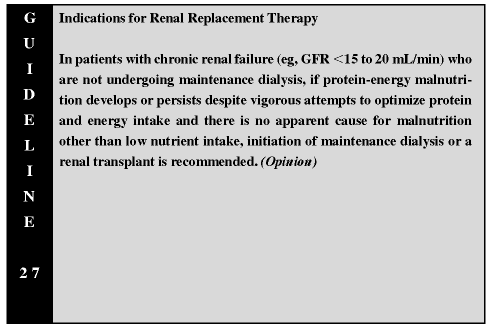

It is well documented that mortality and morbidity are increased in individuals with ESRD who begin dialysis therapy with overt evidence of PEM. Accumulating evidence also indicates that initiation of dialysis more in line with current NKF-DOQI practice guidelines (ie, GFR ≈10.5 mL/min) results in improved patient outcomes compared with when dialysis is delayed until the GFR is < 5 mL/min and symptomatic uremia and associated medical complications are present.213-215 Furthermore, there is evidence that initiating maintenance dialysis under these circumstances, and when there has been nutritional deterioration, results in an improvement in nutritional indices.215-220 There is no evidence that earlier initiation of dialysis leads to improved nutritional status among patients without overt uremia. Moreover, it has not been established that improved nutritional status at the initiation of dialysis directly leads to improved survival or fewer dialysis-related complications. Despite the lack of evidence from controlled clinical trials, interventions that maintain or improve nutritional status before the requirement for renal replacement therapy are likely to result in improved long-term survival.
There is ample evidence that the survival of patients with ESRD is closely associated with their nutritional status (Guidelines 3 through 6, 8, 18, and 23). These findings have been demonstrated not only in large, diverse populations of prevalent MD patients, but also in patients commencing MD therapy.23,79,221 Hypertension, pre-existing cardiac disease, and low serum albumin concentrations were independently associated with diminished long-term survival in 683 ESRD patients who started dialysis during 1970 through 1989.221 In 1,982 HD patients, a low serum albumin concentration at the initiation of dialysis was associated with a significant increase in the relative risk of death.23 A direct relation between serum albumin and survival and an independent association between modified SGA and survival was observed in 680 incident CPD patients.79 In contrast, in one study no significant associations were found between serum albumin, creatinine, and urea concentrations and survival in incident HD patients.222 The sample size in the latter study was relatively small (n = 139), and 94% of the study sample were Black (83%) or Hispanic (11%).222 No studies have specifically examined the relations among other nutritional indicators (eg, %SBW, PNA, and DXA) and survival in incident HD or peritoneal dialysis patients.
Low-protein (eg, 0.60 g protein/kg/d), high-energy (35 kcal/kg/d) diets may retard the rate of progression of chronic renal disease206-207 and should maintain patients with chronic renal disease in good nutritional status (Guidelines 24 and 25).57,99,208,209,211 However, it is recognized that such low-protein diets may not maintain adequate nutritional status in all patients, particularly if an adequate energy intake is not maintained (Guideline 25).99,211 Furthermore, there is evidence that the spontaneous intake of protein and energy, and other indicators of nutritional status, tend to diminish in patients with progressive CRI who are consuming unregulated diets.196 Therefore, patients with CRI need to undergo nutritional assessment at frequent intervals so that any deterioration in nutritional status can be detected early (Guidelines 23 and 26 and Appendix IV). The plan of care and nutritional interventions outlined in Guideline 18 for the nutritional management of the dialysis patient is also appropriate for patients with progressive CRI.
Because of the association between PEM and poor outcome, it is recommended that MD be initiated or renal transplantation performed in patients with advanced CRF (ie, GFR < 20 mL/min) if there is evidence of deteriorating nutritional status or frank PEM, no other apparent cause for the malnutrition, and efforts to correct the nutritional deterioration or PEM are unsuccessful, despite the absence of other traditional indications for dialysis (eg, pericarditis or hyperkalemia). Although the following criteria are not considered rigid or definitive, initiation of renal replacement therapy should be considered if, despite vigorous attempts to optimize protein and energy intake, any of the following nutritional indicators show evidence of deterioration: (1) more than a 6% involuntary reduction in edema-free usual body weight (%UBW) or to less than 90% of standard body weight (NHANES II) in less than 6 months; (2) a reduction in serum albumin by greater than or equal to 0.3 g/dL and to less to than 4.0 g/dL (Guideline 3), in the absence of acute infection or inflammation, confirmed by repeat laboratory testing; or (3) a deterioration in SGA by one category (ie, normal, mild, moderate, or severe; Guideline 9 and Appendix VI).